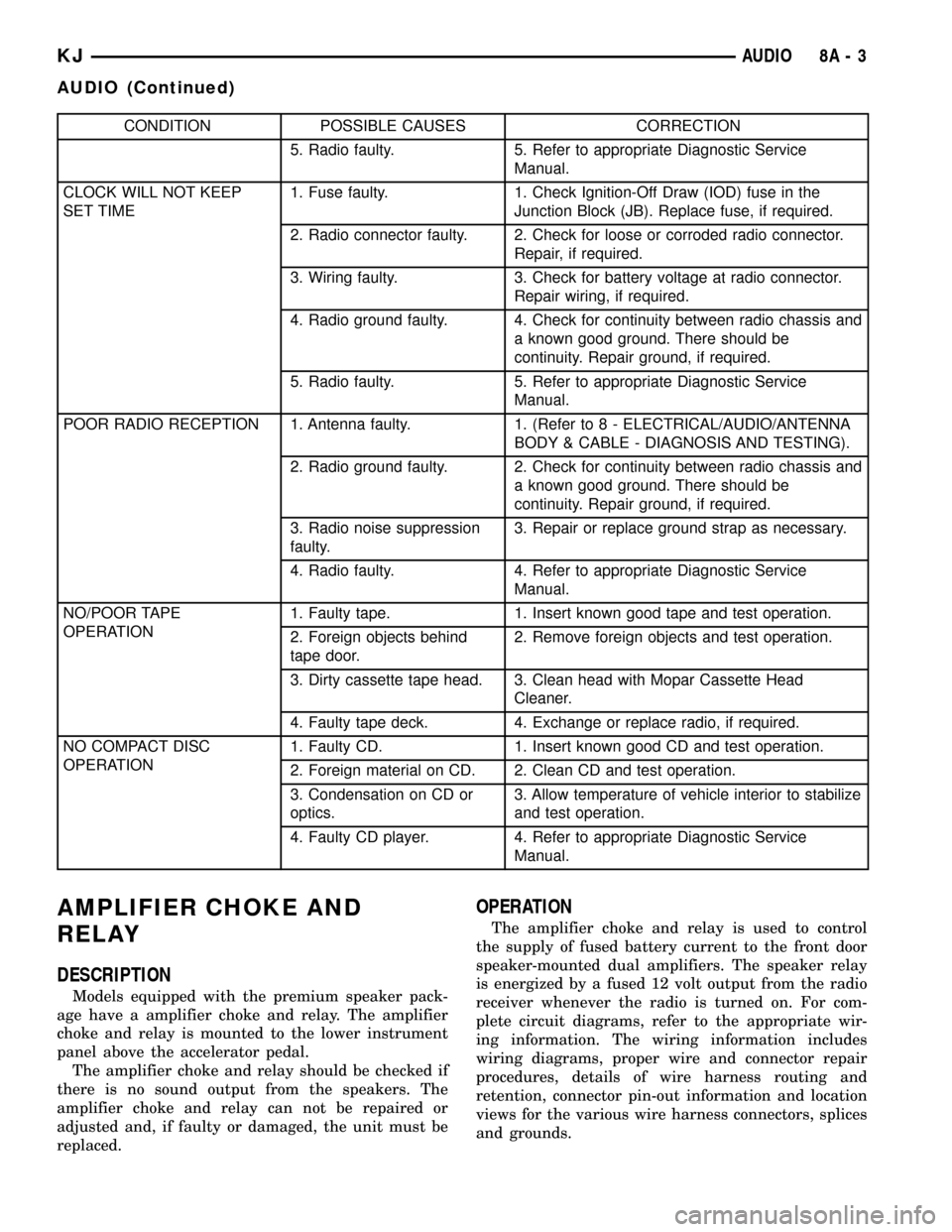relay JEEP LIBERTY 2002 KJ / 1.G User Guide
[x] Cancel search | Manufacturer: JEEP, Model Year: 2002, Model line: LIBERTY, Model: JEEP LIBERTY 2002 KJ / 1.GPages: 1803, PDF Size: 62.3 MB
Page 254 of 1803

CONDITION POSSIBLE CAUSES CORRECTION
8. Incorrect coolant concentration 8. Check coolant. (Refer to 7 -
COOLING/ENGINE/COOLANT -
DESCRIPTION) for correct
coolant/water mixture ratio.
9. Fan installed backwards on
viscous drive.9. Mount fan on drive correctly.
10. Radiator or A/C condenser fins
are dirty or clogged.10. Remove insects and debris.
(Refer to 7 - COOLING/ENGINE/
RADIATOR - CLEANING).
11. Radiator core is corroded or
plugged.11. Have radiator re-cored or
replaced.
12. Fuel or ignition system
problems.12. Refer to FUEL and /or
IGNITION CONTROL for diagnosis.
13. Dragging brakes. 13. Check and correct as
necessary. (Refer to 5 - BRAKES -
DIAGNOSIS AND TESTING) for
correct procedures.
14. Bug screen or cardboard is
being used, reducing airflow.14. Remove bug screen or
cardboard.
15. Thermostat partially or
completely shut.15. Check thermostat operation and
replaces necessary. (Refer to 7 -
COOLING/ENGINE/ENGINE
COOLANT THERMOSTAT -
DIAGNOSIS AND TESTING).
16. Viscous fan drive not operating
properly.16. Check fan drive operation and
replace as necessary. (Refer to 7 -
COOLING/ENGINE/FAN DRIVE
VISCOUS CLUTCH - DIAGNOSIS
AND TESTING).
17. Cylinder head gasket leaking. 17. Check for cylinder head gasket
leaks. (Refer to 7 - COOLING -
DIAGNOSIS AND TESTING). For
repair, (Refer to 9 - ENGINE/
CYLINDER HEAD - REMOVAL).
18. Heater core leaking. 18. Check heater core for leaks.
(Refer to 24 - HEATING & AIR
CONDITIONING/PLUMBING/
HEATER CORE - REMOVAL).
Repair as necessary.
19. Electric fan not functioning. 19. Inspect electric fan for proper
operation. Refer to Electric Cooling
Fan in this section. Refer to Group
8W for electric cooling fan and relay
circuit schematic data.
KJCOOLING - 2.4L7s-7
COOLING - 2.4L (Continued)
Page 268 of 1803

ENGINE COOLANT
TEMPERATURE SENSOR
DESCRIPTION
The Engine Coolant Temperature (ECT) sensor is
used to sense engine coolant temperature. The sensor
protrudes into an engine water jacket.
The ECT sensor is a two-wire Negative Thermal
Coefficient (NTC) sensor. Meaning, as engine coolant
temperature increases, resistance (voltage) in the
sensor decreases. As temperature decreases, resis-
tance (voltage) in the sensor increases.
OPERATION
At key-on, the Powertrain Control Module (PCM)
sends out a regulated 5 volt signal to the ECT sensor.
The PCM then monitors the signal as it passes
through the ECT sensor to the sensor ground (sensor
return).
When the engine is cold, the PCM will operate in
Open Loop cycle. It will demand slightly richer air-
fuel mixtures and higher idle speeds. This is done
until normal operating temperatures are reached.
The PCM uses inputs from the ECT sensor for the
following calculations:
²for engine coolant temperature gauge operation
through CCD or PCI (J1850) communications
²Injector pulse-width²Spark-advance curves
²ASD relay shut-down times
²Idle Air Control (IAC) motor key-on steps
²Pulse-width prime-shot during cranking
²O2 sensor closed loop times
²Purge solenoid on/off times
²EGR solenoid on/off times (if equipped)
²Leak Detection Pump operation (if equipped)
²Radiator fan relay on/off times (if equipped)
²Target idle speed
REMOVAL
2.4L
The Engine Coolant Temperature (ECT) sensor is
installed into a water jacket at left front of cylinder
head (Fig. 2).
WARNING: HOT, PRESSURIZED COOLANT CAN
CAUSE INJURY BY SCALDING. COOLING SYSTEM
MUST BE PARTIALLY DRAINED BEFORE REMOV-
ING THE COOLANT TEMPERATURE SENSOR.
(1) Partially drain cooling system.
(2) Disconnect electrical connector from sensor.
(3) Remove sensor from cylinder head.
3.7L
The Engine Coolant Temperature (ECT) sensor is
installed into a water jacket at front of intake mani-
fold near rear of generator (Fig. 3).
Fig. 1 ENGINE BLOCK HEATER 2.4L
1 - CORE HOLE
2 - BLOCK HEATER
3 - POWER CORD
Fig. 2 ECT AND UPPER TIMING BELT COVER/
BOLTS-2.4L
1 - UPPER TIMING BELT COVER
2 - ELECTRICAL CONNECTOR (ECT)
3 - MOUNTING BOLTS (3)
KJENGINE7s-21
ENGINE BLOCK HEATER - 2.4L (Continued)
Page 273 of 1803

RADIATOR FAN - ELECTRIC
DESCRIPTION
The fan (Fig. 11) is electrically controlled by the
powertrain control module (PCM) through the fan
control relay. This relay is located on the left wheel
house in the engine compartment.
OPERATION
The electric radiator cooling fan is controlled by
the Powertrain Control Module (PCM) through the
radiator cooling fan relay. The PCM regulates fan
operation based on input from the engine coolant
temperature sensor, battery temperature sensor,air
conditioning select switch and vehicle speed.
The fan is not energized during engine cranking
regardless of the electrical input from the tempera-
ture sensors and ,air conditioning switch. However, if
engine operation conditions warrant fan engagement,
the fan will run once engine starts.
On vehicles NOT equipped with AC:The relay
is energized when the coolant temperature is above
80É C (176É F), or battery temperature sensor above ±
12É C (10É F). It will then de-energize when coolant
temperature drops below 82É C (180É F), or batter
temperature sensor below ± 9É C ( 16É F).
Vehicles Equipped with AC:In addition to using
coolant temperature and battery temperature sensorto control cooling fan operation, the cooling fan will
also be engaged when the ,air conditioning system is
activated. The relay is also energized when, air con-
ditioning is selected and coolant temperature is
above 95É C ( 203É F), or , air conditioning is selected
and battery temperature sensor is above 41É C (106É
F). It will then de-energize when , air conditioning is
selected and coolant temperature is below 92É C
(198É F), or , air conditioning is selected and battery
temperature is below 38É C (100É F).
REMOVAL
If the fan blade is bent, warped, cracked or dam-
aged in any way, it must be replacedonlywith a
replacement fan blade.Do not attempt to repair a
damaged fan blade.
NOTE: For 3.7L Heavy Duty/Max Cool/Trailer Tow
cooling package, the viscous fan cannot be
removed seperate from the shroud. Both fan and
shroud must be removed together.
(1) Disconnect battery negative cable.
(2) Using special tool 6958 spanner wrench and
8346 adapters, remove the viscous fan from the
water pump (Fig. 12).
(3) Gently lay fan into shroud.
(4) Disconnect the electrical connector for the elec-
tric fan, then disconnect connector from shroud.
Fig. 11 Radiator Cooling Fan - Typical
1 - RADIATOR
2 - ELECTRIC COOLING FAN CONNECTOR
3 - FAN SHROUD
4 - ELECTRIC COOLING FAN
Fig. 12 Viscous Fan and Fan Drive 3.7L
1 - SPECIAL TOOL 6958 SPANNER WRENCH WITH ADAPTER
PINS 8346
2-FAN
7s - 26 ENGINEKJ
Page 278 of 1803

AUDIO
TABLE OF CONTENTS
page page
AUDIO
DESCRIPTION..........................1
OPERATION............................1
DIAGNOSIS AND TESTING - AUDIO..........2
AMPLIFIER CHOKE AND RELAY
DESCRIPTION..........................3
OPERATION............................3
DIAGNOSIS AND TESTING - AMPLIFIER
CHOKE AND RELAY....................4
REMOVAL.............................4
INSTALLATION..........................4
ANTENNA BODY & CABLE
DESCRIPTION..........................4
OPERATION............................5
DIAGNOSIS AND TESTING - ANTENNA BODY
AND CABLE..........................5
REMOVAL.............................6
INSTALLATION..........................6
CD CHANGER
DESCRIPTION..........................7
OPERATION............................7
REMOVAL.............................7
INSTALLATION..........................7
INSTRUMENT PANEL ANTENNA CABLE
REMOVAL.............................7INSTALLATION..........................8
RADIO
DESCRIPTION..........................8
OPERATION............................8
REMOVAL.............................9
INSTALLATION..........................9
RADIO NOISE SUPPRESSION GROUND STRAP
DESCRIPTION..........................9
OPERATION...........................10
REMOVAL.............................10
INSTALLATION.........................11
REMOTE SWITCHES
DESCRIPTION.........................11
OPERATION...........................12
DIAGNOSIS AND TESTING - REMOTE
SWITCHES..........................12
REMOVAL.............................13
INSTALLATION.........................13
SPEAKER
DESCRIPTION.........................13
OPERATION...........................14
REMOVAL.............................14
INSTALLATION.........................15
AUDIO
DESCRIPTION
An audio system is standard factory-installed
equipment on this model. Several combinations of
radio receivers and speaker systems are offered on
this model. The audio system uses an ignition
switched source of battery current so that the system
will only operate when the ignition switch is in the
RUN or ACCESSORY positions.
The audio system includes the following compo-
nents:
²Amplifier choke and relay
²Antenna
²Compact disc changer (if equipped)
²Power amplifier mounted to each front door
speaker (with premium speaker system only)
²Radio noise suppression components
²Radio receiver
²Remote radio switches (if equipped)
²SpeakersCertain functions and features of the audio system
rely upon resources shared with other electronic
modules in the vehicle over the Programmable Com-
munication Interface (PCI) bus network. The data
bus network allows the sharing of sensor informa-
tion. For diagnosis of these electronic modules or of
the data bus network, the use of a DRB scan tool and
the proper Diagnostic Procedures manual are recom-
mended.
Refer to the appropriate wiring information for
complete standard and premium audio system circuit
diagrams. The wiring information includes proper
wire and connector repair procedures, further details
on wire harness routing and retention, as well as
pin-out and location views for the various wire har-
ness connectors, splices, and grounds.
OPERATION
The audio system components are designed to pro-
vide audio entertainment and information through
the reception, tuning and amplification of locally
broadcast radio signals in both the Amplitude Modu-
KJAUDIO 8A - 1
Page 280 of 1803

CONDITION POSSIBLE CAUSES CORRECTION
5. Radio faulty. 5. Refer to appropriate Diagnostic Service
Manual.
CLOCK WILL NOT KEEP
SET TIME1. Fuse faulty. 1. Check Ignition-Off Draw (IOD) fuse in the
Junction Block (JB). Replace fuse, if required.
2. Radio connector faulty. 2. Check for loose or corroded radio connector.
Repair, if required.
3. Wiring faulty. 3. Check for battery voltage at radio connector.
Repair wiring, if required.
4. Radio ground faulty. 4. Check for continuity between radio chassis and
a known good ground. There should be
continuity. Repair ground, if required.
5. Radio faulty. 5. Refer to appropriate Diagnostic Service
Manual.
POOR RADIO RECEPTION 1. Antenna faulty. 1. (Refer to 8 - ELECTRICAL/AUDIO/ANTENNA
BODY & CABLE - DIAGNOSIS AND TESTING).
2. Radio ground faulty. 2. Check for continuity between radio chassis and
a known good ground. There should be
continuity. Repair ground, if required.
3. Radio noise suppression
faulty.3. Repair or replace ground strap as necessary.
4. Radio faulty. 4. Refer to appropriate Diagnostic Service
Manual.
NO/POOR TAPE
OPERATION1. Faulty tape. 1. Insert known good tape and test operation.
2. Foreign objects behind
tape door.2. Remove foreign objects and test operation.
3. Dirty cassette tape head. 3. Clean head with Mopar Cassette Head
Cleaner.
4. Faulty tape deck. 4. Exchange or replace radio, if required.
NO COMPACT DISC
OPERATION1. Faulty CD. 1. Insert known good CD and test operation.
2. Foreign material on CD. 2. Clean CD and test operation.
3. Condensation on CD or
optics.3. Allow temperature of vehicle interior to stabilize
and test operation.
4. Faulty CD player. 4. Refer to appropriate Diagnostic Service
Manual.
AMPLIFIER CHOKE AND
RELAY
DESCRIPTION
Models equipped with the premium speaker pack-
age have a amplifier choke and relay. The amplifier
choke and relay is mounted to the lower instrument
panel above the accelerator pedal.
The amplifier choke and relay should be checked if
there is no sound output from the speakers. The
amplifier choke and relay can not be repaired or
adjusted and, if faulty or damaged, the unit must be
replaced.
OPERATION
The amplifier choke and relay is used to control
the supply of fused battery current to the front door
speaker-mounted dual amplifiers. The speaker relay
is energized by a fused 12 volt output from the radio
receiver whenever the radio is turned on. For com-
plete circuit diagrams, refer to the appropriate wir-
ing information. The wiring information includes
wiring diagrams, proper wire and connector repair
procedures, details of wire harness routing and
retention, connector pin-out information and location
views for the various wire harness connectors, splices
and grounds.
KJAUDIO 8A - 3
AUDIO (Continued)
Page 281 of 1803

DIAGNOSIS AND TESTING - AMPLIFIER
CHOKE AND RELAY
Any diagnosis of the Audio system should
begin with the use of the DRB diagnostic tool.
For information on the use of the DRB, refer to
the appropriate Diagnostic Service Manual.
The amplifier choke and relay is used to switch
power to the individual speaker amplifiers used with
the premium speaker package. The amplifier choke
and relay is serviced only as a unit. If all of the
speakers are inoperative the amplifier choke and
relay should be inspected. Before replacement, make
the following inspections of the amplifier choke and
relay circuits. For complete circuit diagrams, refer to
the appropriate wiring information. The wiring infor-
mation includes wiring diagrams, proper wire and
connector repair procedures, details of wire harness
routing and retention, connector pin-out information
and location views for the various wire harness con-
nectors, splices and grounds.
(1)
Check the fused B(+) fuse in the junction block. If
OK, go to Step 2. If not OK, replace the faulty fuse.
(2) Check for battery voltage at the fused B(+) fuse
in the junction block. If OK, go to Step 3. If not OK,
repair the open fused B(+) circuit to the battery as
required.
(3) Disconnect the instrument panel wire harness
connector from the amplifier choke and relay. Check
for battery voltage at the fused B(+) circuit cavity of
the instrument panel wire harness connector for the
amplifier choke and relay. If OK, go to Step 4. If not
OK, repair the open fused B(+) circuit to the junction
block fuse as required.
(4) Probe the ground circuit cavity of the instru-
ment panel wire harness connector for the amplifier
choke and relay. Check for continuity to a good
ground. There should be continuity. If OK, go to Step
5. If not OK, repair the open ground circuit to ground
as required.
(5) Turn the ignition switch to the RUN position
and turn the radio ON. Check for battery voltage at
the radio 12-volt output circuit cavity of the instru-
ment panel wire harness connector for the amplifier
choke and relay. If OK, go to Step 6. If not OK,
repair the open radio 12-volt output circuit to the
radio as required.
(6) Turn the radio and ignition switches to the
OFF position. Reconnect the instrument panel wire
harness connector to the amplifier choke and relay.
Check for battery voltage at the amplified speaker
(+) circuit cavity of the instrument panel wire har-
ness connector for the amplifier choke and relay.
There should be zero volts. Turn the ignition and
radio switches to the ON position. There should now
be battery voltage. If OK, repair the open amplified
speaker (+) circuits to the speaker-mounted amplifi-ers as required. If not OK, replace the faulty ampli-
fier choke and relay.
REMOVAL
(1) Disconnect and isolate the battery negative
cable.
(2) Remove knee blocker cover and knee blocker.
(3) Disconnect the electrical harness connector
from the amplifier choke and relay (Fig. 1).
(4) Remove mounting screws and amplifier choke
and relay.
INSTALLATION
(1) Install the amplifier choke and relay.
(2) Install the mounting screws.
(3) Connect the electrical harness connector.
(4) Install knee blocker cover and knee blocker.
(5) Connect the battery negative cable.
ANTENNA BODY & CABLE
DESCRIPTION
The antenna body and cable is secured below the
fender panel by the antenna cap nut through a
mounting hole in the side of the right front fender.
The primary coaxial antenna cable is then routed
beneath the fender sheet metal and through a entry
hole in the right cowl side panel into the interior of
the vehicle. Inside the vehicle, the primary coaxial
cable is connected to a secondary instrument panel
antenna coaxial cable with an in-line connector that
is located behind the right kick panel. The secondary
coaxial cable is then routed behind the instrument
panel to the back of the radio.
Fig. 1 RADIO CHOKE
1 - RADIO CHOKE
2 - MOUNTING SCREWS
8A - 4 AUDIOKJ
AMPLIFIER CHOKE AND RELAY (Continued)
Page 300 of 1803

ELECTRONIC CONTROL MODULES
TABLE OF CONTENTS
page page
ELECTRONIC CONTROL MODULES
STANDARD PROCEDURE - PCM/SKIM
PROGRAMMING.......................1
BODY CONTROL MODULE
DESCRIPTION..........................2
OPERATION............................5
DIAGNOSIS AND TESTING - BODY CONTROL
MODULE.............................7
REMOVAL.............................7
INSTALLATION..........................7
COMMUNICATION
DESCRIPTION..........................8
OPERATION............................8
CONTROLLER ANTILOCK BRAKE
REMOVAL.............................10
INSTALLATION.........................10
DATA LINK CONNECTOR
DESCRIPTION - DATA LINK CONNECTOR....10
OPERATION - DATA LINK CONNECTOR......10
POWERTRAIN CONTROL MODULE
DESCRIPTION
DESCRIPTION - PCM..................11
DESCRIPTION - MODES OF OPERATION . . . 11
DESCRIPTION - 5 VOLT SUPPLIES.......13
DESCRIPTION - IGNITION CIRCUIT SENSE . 13DESCRIPTION - POWER GROUNDS......13
DESCRIPTION - SENSOR RETURN.......14
OPERATION
OPERATION - PCM....................14
OPERATION - 5 VOLT SUPPLIES.........15
OPERATION - IGNITION CIRCUIT SENSE . . . 15
REMOVAL.............................15
INSTALLATION.........................15
SENTRY KEY IMMOBILIZER MODULE
DESCRIPTION.........................15
OPERATION...........................16
REMOVAL.............................17
INSTALLATION.........................18
TRANSMISSION CONTROL MODULE
DESCRIPTION.........................18
OPERATION...........................18
STANDARD PROCEDURE - TCM QUICK
LEARN..............................21
HEATED SEAT MODULE
DESCRIPTION.........................21
OPERATION...........................21
DIAGNOSIS AND TESTING - HEATED SEAT
MODULE............................22
REMOVAL.............................24
INSTALLATION.........................24
ELECTRONIC CONTROL
MODULES
STANDARD PROCEDURE - PCM/SKIM
PROGRAMMING
NOTE: Before replacing the PCM for a failed driver,
control circuit, or ground circuit, be sure to check
the related component/circuit integrity for failures
not detected due to a double fault in the circuit.
Most PCM driver/control circuit failures are caused
by internal component failures (i.e. relays and sole-
noids) and shorted circuits (i.e. pull-ups, drivers,
and switched circuits). These failures are difficult to
detect when a double fault has occurred and only
one DTC has been set.
When a PCM (JTEC) and the SKIM are replaced
at the same time, perform the following steps in
order:
(1) Program the new PCM (JTEC).(2) Program the new SKIM.
(3) Replace all ignition keys and program them to
the new SKIM.
PROGRAMMING THE PCM (JTEC)
The SKIS Secret Key is an ID code that is unique
to each SKIM. This code is programmed and stored
in the SKIM, the PCM, and the ignition key tran-
sponder chip(s). When replacing the PCM, it is nec-
essary to program the secret key into the new PCM
using the DRBIIItscan tool. Perform the following
steps to program the secret key into the PCM.
(1) Turn the ignition switch to the On position
(transmission in Park/Neutral).
(2) Use the DRBIIItand select THEFT ALARM,
SKIM, then MISCELLANEOUS.
(3) Select PCM REPLACED (GAS ENGINE).
(4) Enter secured access mode by entering the
vehicle four-digit PIN.
(5) Select ENTER to update PCM VIN.
KJELECTRONIC CONTROL MODULES 8E - 1
Page 301 of 1803

NOTE: If three attempts are made to enter secured
access mode using an incorrect PIN, secured
access mode will be locked out for one hour. To
exit this lockout mode, turn the ignition switch to
the ON position for one hour, then enter the correct
PIN. (Ensure all accessories are turned off. Also
monitor the battery state and connect a battery
charger if necessary).
(6) Press ENTER to transfer the secret key (the
SKIM will send the secret key to the PCM).
(7) Press PAGE BACK to get to the Select System
menu and select ENGINE, MISCELLANEOUS, and
SRI MEMORY CHECK.
(8) The DRBIIItwill ask, ªIs odometer reading
between XX and XX?º Select the YES or NO button
on the DRBIIIt. If NO is selected, the DRBIIItwill
read, ªEnter Odometer Reading (From I.P. odome-
ter)º. Enter the odometer reading from the instru-
ment cluster and press ENTER.
PROGRAMMING THE SKIM
(1) Turn the ignition switch to the On position
(transmission in Park/Neutral).
(2) Use the DRBIIItand select THEFT ALARM,
SKIM, then MISCELLANEOUS.
(3) Select PCM REPLACED (GAS ENGINE).
(4) Program the vehicle four-digit PIN into SKIM.
(5) Select COUNTRY CODE and enter the correct
country.
NOTE: Be sure to enter the correct country code. If
the incorrect country code is programmed into
SKIM, it cannot be changed and the SKIM must be
replaced.
(6) Select YES to update VIN (the SKIM will learn
the VIN from the PCM).
(7) Press ENTER to transfer the secret key (the
PCM will send the secret key to the SKIM).
(8) Program ignition keys to the SKIM.
NOTE: If the PCM and the SKIM are replaced at the
same time, all vehicle ignition keys will need to be
replaced and programmed to the new SKIM.
PROGRAMMING IGNITION KEYS TO THE SKIM
(1) Turn the ignition switch to the On position
(transmission in Park/Neutral).
(2) Use the DRBIIItand select THEFT ALARM,
SKIM, then MISCELLANEOUS.
(3) Select PROGRAM IGNITION KEY'S.
(4) Enter secured access mode by entering the
vehicle four-digit PIN.NOTE: A maximum of eight keys can be learned to
each SKIM. Once a key is learned to a SKIM it (the
key) cannot be transferred to another vehicle.
(5) Obtain ignition keys to be programmed from
the customer (8 keys maximum).
(6) Using the DRBIIIt, erase all ignition keys by
selecting MISCELLANEOUS, and ERASE ALL CUR-
RENT IGN. KEYS.
(7) Program all of the ignition keys.
If ignition key programming is unsuccessful, the
DRBIIItwill display one of the following messages:
²Programming Not Attempted- The DRBIIIt
attempts to read the programmed key status and
there are no keys programmed into SKIM memory.
²Programming Key Failed (Possible Used
Key From Wrong Vehicle)- SKIM is unable to pro-
gram an ignition key transponder due to one of the
following:
²The ignition key transponder is faulty.
²The ignition key transponder is or has been
already programmed to another vehicle.
²8 Keys Already Learned, Programming Not
Done- The SKIM transponder ID memory is full.
²Learned Key In Ignition- The ID for the igni-
tion key transponder currently in the ignition lock
cylinder is already programmed in SKIM memory.
BODY CONTROL MODULE
DESCRIPTION
A Body Control Module (BCM) is concealed behind
the driver side end of the instrument panel in the
passenger compartment, where it is secured to the
fuse panel side of the Junction Block (JB) with four
screws (Fig. 1). The JB is the interface between the
body, the instrument panel, and the headlamp and
dash wire harnesses. The JB also contains the fuses
and relays used for the interior electrical system of
the vehicle. The BCM is enclosed in a molded plastic
housing with two integral external connector recepta-
cles that connect it to the vehicle electrical system
through two take outs with connectors from the
instrument panel wire harness (Fig. 2). The BCM
also has an integral interface connector concealed on
the back side of the unit that joins it through a con-
nector receptacle that is integral to the JB housing to
the circuitry within the JB. This connector is referred
to as the JB-BCM connector. The combined BCM and
JB are sometimes referred to as the Junction Block
Module (JBM).
8E - 2 ELECTRONIC CONTROL MODULESKJ
ELECTRONIC CONTROL MODULES (Continued)
Page 302 of 1803

There are two different versions of the BCM: base
and premium. The base BCM is a subset of the com-
ponents in the premium version. Basically, the base
version BCM does not support the following features:
Compass Mini-Trip Computer (CMTC), fog lamps
(front and/or rear), Remote Keyless Entry (RKE),
remote radio switches, or Vehicle Theft Security Sys-
tem (VTSS). Both versions of the BCM utilize inte-
grated circuitry and information carried on the
Programmable Communications Interface (PCI) databus network along with many hard wired inputs to
monitor many sensor and switch inputs throughout
the vehicle. In response to those inputs, the internal
circuitry and programming of the BCM allow it to
control and integrate many electronic functions and
features of the vehicle through both hard wired out-
puts and the transmission of electronic message out-
puts to other electronic modules in the vehicle over
the PCI data bus. The electronic functions and fea-
tures that the BCM supports or controls include the
following:
²A/C Select Switch Status- The BCM monitors
an input from, and transmits the status of the A/C
switch on the heater-A/C control.
²Ambient Temperature Data- The premium
BCM monitors and transmits the ambient tempera-
ture sensor input data.
²Cargo Lamp Disable- The BCM monitors an
input from the cargo lamp switch to provide an inte-
rior lighting disable feature.
²Chimes- The chime tone generator is located
on the ElectroMechanical Instrument Cluster (EMIC)
circuit board, but the EMIC goes to sleep with the
ignition switch in the Off position. The BCM provides
a wake-up output to the EMIC based upon inputs
from the key-in ignition switch or the exterior light-
ing switch, then sends electronic chime request mes-
sages to the EMIC for the headlamps-on warning
and key-in ignition warning.
²Door Lock Inhibit- The BCM monitors the
key-in ignition switch and the driver side front door
ajar switch to provide a door lock inhibit feature.
²Exterior Lamp Load Shedding- The BCM
provides a battery saver feature which will automat-
ically turn off exterior lamps that remain on after a
timed interval.
²Exterior Lamp Status- The BCM monitors
the status of the park lamp, low beam, high beam or
Daytime Running Lamp (DRL - Canada only), front
fog lamp (optional), and rear fog lamp (in required
markets only) relays.
²Exterior Lighting Control- The BCM pro-
vides exterior lamp control for standard head and
park lamps, as well as Daytime Running Lamps
(DRL - Canada only), front fog lamps (optional), and
rear fog lamps (in required markets only). This
includes support for features including optical horn
(also known as flash-to-pass) and headlamp time
delay.
²Flip-Up Glass Control- The BCM monitors
the tailgate cylinder lock switch, the tailgate handle
switch, the Remote Keyless Entry (RKE) module
inputs and the rear wiper switch to provide control
for the rear flip-up glass actuator.
Fig. 1 Body Control Module Location
1 - DRIVER DOOR
2 - INSTRUMENT PANEL END BRACKET
3 - JUNCTION BLOCK
4 - BODY CONTROL MODULE
Fig. 2 Body Control Module
1 - BODY CONTROL MODULE (FRONT VIEW)
2 - REMOTE KEYLESS ENTRY MODULE RECEPTACLE
3 - BCM-RKE CONNECTOR
4 - BODY CONTROL MODULE (BACK VIEW)
5 - JB-BCM CONNECTOR
6 - CONNECTOR RECEPTACLE (2)
KJELECTRONIC CONTROL MODULES 8E - 3
BODY CONTROL MODULE (Continued)
Page 303 of 1803

²Fog Lamp Control- The premium BCM pro-
vides fog lamp control for front fog lamps (optional),
and rear fog lamps (in required markets only).
²Front Wiper System Status- The BCM moni-
tors the status of the front wiper motor park switch.
²Fuel Economy and Distance to Empty Cal-
culations- The BCM calculates and transmits the
fuel economy and Distance To Empty (DTE) data.
²Headlamp Time Delay- The BCM provides a
headlamp time delay feature with the ignition switch
in the Off position.
²Heated Rear Glass Control- The BCM pro-
vides control and timer functions for the heated rear
glass feature and transmits the system status.
²Ignition On/Off Timer- The BCM monitors
and transmits the elapsed ignition On timer data
and monitors the ignition Off time.
²Ignition Switch Position Status- The BCM
monitors and transmits the status of the ignition
switch.
²Instrument Panel Dimming- The BCM mon-
itors and transmits the selected illumination inten-
sity level of the panel lamps dimmer switch.
²Interior Lamp Load Shedding- The BCM
provides a battery saver feature which will automat-
ically turn off all interior lamps that remain on after
a timed interval.
²Interior Lighting Control- The BCM moni-
tors inputs from the interior lighting switch, the door
ajar switches, the flip-up glass ajar switch, the tail-
gate ajar switch, the cargo lamp switch, the reading
lamp switches, and the Remote Keyless Entry (RKE)
module to provide courtesy lamp control. This
includes support for timed illuminated entry with
theater-style fade-to-off and courtesy illumination
defeat features.
²Intermittent Wipe and Front Wiper System
Control- The BCM monitors inputs from the front
wiper and washer switch and the front wiper motor
park switch to provide front wiper system control
through the wiper on/off and high/low relays. This
includes support for adjustable intermittent wipe,
mist wipe (also known as pulse wipe), and wipe-after-
wash features.
²Key-In-Ignition Switch Status- The BCM
monitors and transmits the status of the key-in-igni-
tion switch.
²Panic Mode- The BCM provides support for
the Remote Keyless Entry (RKE) system panic mode
feature.
²Parade Mode- The BCM provides a parade
mode (also known as funeral mode) that allows the
interior Vacuum Fluorescent Displays (VFD) to be
illuminated at full intensity while driving in daylight
with the exterior lamps On.²Power Locks- The BCM monitors inputs from
the power lock switches and the Remote Keyless
Entry (RKE) module (optional) to provide control of
the power lock motors through outputs to the lock,
unlock, and driver unlock (RKE only) relays. This
includes support for rolling door locks (also known as
automatic door locks) and a door lock inhibit mode.
²Programmable Features- The BCM provides
support for several standard and optional program-
mable features, including: rolling door locks, head-
lamp time delay interval, Remote Keyless Entry
(RKE) driver-door-only or unlock-all-doors, RKE opti-
cal chirp, and RKE audible chirp.
²Remote Keyless Entry- The premium BCM
provides the optional Remote Keyless Entry (RKE)
system features, including support for the RKE Lock,
Unlock (with optional driver-door-only unlock, and
unlock-all-doors), rear flip-up glass control, Panic,
audible chirp, optical chirp, and illuminated entry
modes, as well as the ability to be programmed to
recognize up to four RKE transmitters.
²Rolling Door Locks- The BCM provides sup-
port for the power lock system rolling door locks fea-
ture (also known as automatic door locks).
²Tailgate and Flip-Up Glass Ajar Status- The
BCM monitors and transmits the status of the tail-
gate and rear flip-up glass ajar switches.
²Remote Radio Switch Interface- The pre-
mium BCM monitors and transmits the status of the
optional remote radio switches.
²Self-Diagnostics- The BCM provides support
for diagnostics through communication with the
DRBIIItscan tool over the PCI data bus network.
Each analog and digital input can be verified, and
each output can be actuated through the use of this
diagnostic protocol. The BCM also stores Diagnostic
Trouble Codes (DTCs) to assist in troubleshooting
this unit.
²Vacuum Fluorescent Display Synchroniza-
tion- The BCM transmits panel lamp intensity data
which allows modules with Vacuum Fluorescent Dis-
plays (VFD) to coordinate their illumination inten-
sity.
²Vehicle Speed System- The BCM monitors a
vehicle speed input from the vehicle speed sensor
(without Antilock Brake System [ABS]) or from the
Controller Antilock Brake (CAB)(with ABS), calcu-
lates the vehicle speed based upon a programmed
axle ratio/tire size (electronic pinion factor), and
transmits the vehicle speed information to the Pow-
ertrain Control Module (PCM) on a hard wired out-
put circuit.
²Vehicle Theft Security System- The pre-
mium BCM monitors inputs from the door cylinder
lock switches, the tailgate cylinder lock switch, the
door ajar switches, the tailgate ajar switch, the
8E - 4 ELECTRONIC CONTROL MODULESKJ
BODY CONTROL MODULE (Continued)